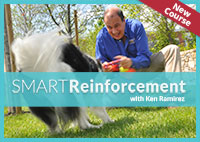Does your dog or puppy beg at the dinner table, or worse, actually steal from your plate? You can take this unwanted behavior and make lemonade from lemons with a little clicker magic.
When a dog wants something, a clicker trainer thinks "Ahh, this could be a useful reinforcer!" The more passionate or persistent your dog is about the object of his desire, the more useful and powerful that reinforcer is when you figure out how to make it work in your favor. Dogs do what works for them, so you might as well make what works for them be the same thing that works for you, too!

Lay the groundwork
Let's start with a simple exercise in self-control, which will illustrate the principles at work here.
Take a yummy treat and hide it in your hand. Present your closed hand to your dog. Most dogs will lick, sniff, nudge, or even paw to try to figure out how to get the yummy treat they can smell inside your closed fist.
Wait until the slightest pause in whatever this behavior may be, then click with your other hand and drop the treat on the floor. Repeat this exercise a few times until your dog starts to understand "Oh, I need to back off in order to get the treat!" This simple exercise, known as "Doggy Zen," is the foundation of self-control.
For some dogs, this will be the first time that they have ever needed to demonstrate self-control around food.
Teach your dog the power of "om"
Now let's have a look at what dogs do at their own dinnertime. Often the picture looks like this: owner spoons or pours food into bowl while dog greedily gobbles half the food up before it even hits the bottom of the dish.
Let's use this enthusiasm to do a little training. What's more, let's take advantage of the opportunity to learn an important life lesson in self-control.
(The following exercise assumes that your dog knows how to "sit." If not, click here to read how to clicker train "sit.")
Ask your dog to "sit" while holding the food bowl with just a little bit of food in it. When he sits, start lowering the bowl to the ground, just a little. If your dog continues to sit, click and place the bowl onto the ground and let him eat the food. If your dog gets up as you lower the bowl, lift the bowl and ask for the "sit" again.
Pick the bowl up and put some more food in it, just a little. Repeat the exercise, but try to lower the bowl a little more this time. If your dog continues to sit, click and place the bowl on the ground and let him eat.
Repeat the exercise in this fashion at dinnertime each day until you can get the bowl all the way to the ground while your dog remains sitting. Don't try to lower it too far too soon. The most important learning is when your dog succeeds, not when he fails.
When your dog gets really good at this exercise and the bowl is all the way on the ground, you can start increasing the amount of time the bowl spends on the ground before you click. Again, don't wait so long that your dog fails. The point of this exercise is for your dog to succeed at sitting patiently, waiting for the click. You can gradually increase the waiting time, second by second, day by day (a simple method for doing this is explained below).
Clicker training is efficient. You may have noticed your dog has now learned to "sit" until released with at least one major distraction (the bowl of food).
When your dog can wait for 30 seconds while you walk away from the bowl, your dog has developed some industrial-strength self-control. This dog has "Zen monk-like" powers of self-discipline!
Imagine what would happen if you could do this exercise at each meal, and then throw in a few more self-control exercises? Got a dog who chases cats? Would "Zen Monk Dog" chase cats? Got a dog who races through doors? Would "Zen Monk Dog" race through doors? Got a dog who jumps on visitors? Would "Zen Monk Dog" jump on visitors?
Probably! But it wouldn't take a whole lot of training to teach "Zen Monk Dog" not to do any of these things. Don't forget, this dog waits while you walk away from his dinner bowl! What could be a greater demonstration of self-control?
The truly beautiful thing about clicker training is that we become conditioned (eventually) to see problems as opportunities. When we have a problem, we say "What would I like my dog to do instead of [insert unwanted behavior problem here]?" We train instead of blame or shame.
Gone are the days of immediately reacting to a situation and saying to ourselves "How do I stop this [unwanted behavior]?" It's OK to want to stop unwanted behavior, but it's not very instructive. What does our dog do instead? How do we both get what we want in this relationship?
Dinner for two--or three--or four
Let's imagine the perfect evening (this is mine, but you can insert your own here). Soft candlelight, delicious meal, gorgeous company, a bottle of Tasmanian Pinot, a little Django Reinhardt on the stereo—and my two dogs (Sabella and Django) lying peacefully by the table. Not drooling, not begging, not jumping into my lap, not bringing me a slobbery tennis ball—just lying peacefully by the table.
How does this idyllic scenario become reality? The candles, food, company, wine, and music are up to you, but here's what to do about the dogs lying peacefully by the table.
Set your dog up for success. First, you need to teach your dog to lie down amid the distraction of dinnertime.
(It's a good idea to avoid doing this exercise during your actual dinnertime. Shut your dogs out of the dining area when you eat your normal meals for the time being. When you can't or shouldn't train, manage instead.)
If you have more than one dog, it's best to work with just one dog at a time. Shut the other dog(s) out of the dining area. Then you need a reinforcer; preferably your dog's normal meal. If you feed a kibble, then just have a clean bowl of kibble on the table. If you feed something else, cut it into little pieces and have that in a clean bowl on the table with your clicker at the ready. Sit down as if you were about to eat dinner.
Ask your dog to lie "down" (or lure him down), then count to one silently in your head. Click and treat. If necessary, ask your dog to "down" again. Immediately count to two in your head. Click and treat. If necessary, ask your dog to "down" again. Immediately count to three in your head. Click and treat.
If your dog gets up while you are counting, calmly tell him "down" and restart your base count at one.
To clarify, on each successful trial, increase your count by one each time. If you have an unsuccessful trial, restart at the base count of one. Your pattern might look something like this:
1, click & treat
1,2, click & treat
1,2,3, click & treat
1,2,3 (dog gets up, ask dog to "down" again)
1, click & treat
1,2, click & treat
1,2,3, click & treat, etc.
When you can count to 30 without your dog getting up, then you can start doing this while you eat your dinner.
If you have more than one dog, work with each dog individually until you can count to 30, then work with both dogs together. Click and treat both dogs on the same schedule. If one dog gets up then restart at the base count for both of them. When both dogs can get to 30 seconds together, then you are ready to use this program while you eat your dinner.
I like "lying down peacefully" to be a default behavior while I am eating my dinner. For this reason I don't cue the behavior. By this stage, most dogs will have figured out that they need to be lying down when I'm at the table and will not need any extra cues.
Don't be afraid to use a little of your dinner to reinforce this wonderful behavior, so long as it is healthy and OK for dogs to eat.
If you're worried about having to count through meals every night, stop worrying. It won't take long to develop the duration of this behavior to the point that you can stop counting and just click and treat randomly. If you want to take a break from training before you get to this point, just shut your dog out of the dining area and enjoy your meal without counting.
When your dog can perform these exercises then he or she is truly a "Zen Monk Dog" with industrial-strength powers of self-control! Other remarkable feats of self-control are sure to follow now that (a) your dog has learned to show some self-control and (b) you have learned how to train for self-control. Why not start training now?
© 2006 Aidan Bindoff, www.positivepetzine.com








well done
This step by step format is very useful. I have started it today. Working individually I had a good response to waiting once the food was down even with my chow hound Pablo. One on one the girls are polite. However, in a group they are not. It will be interesting to see how long it takes me to work with all 3.
Best wishes,
Ri
Rita Ippolito
www.savagemermaidswildpugs.com
Post new comment